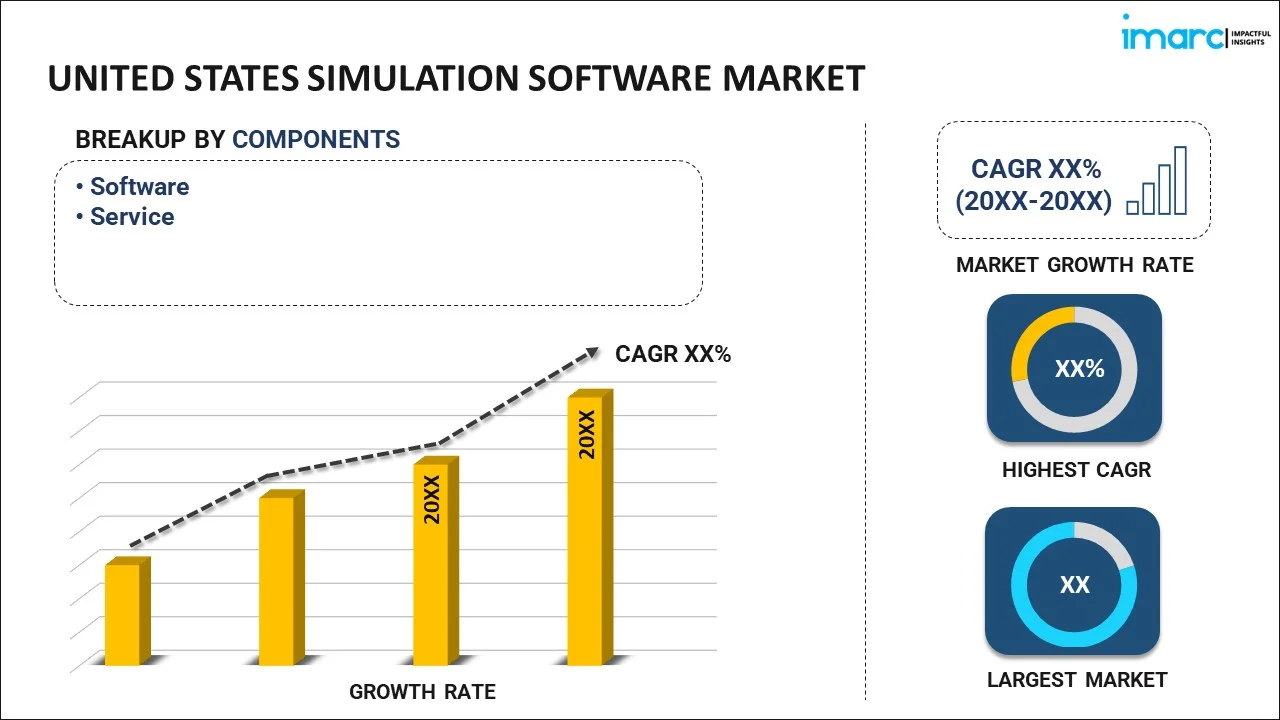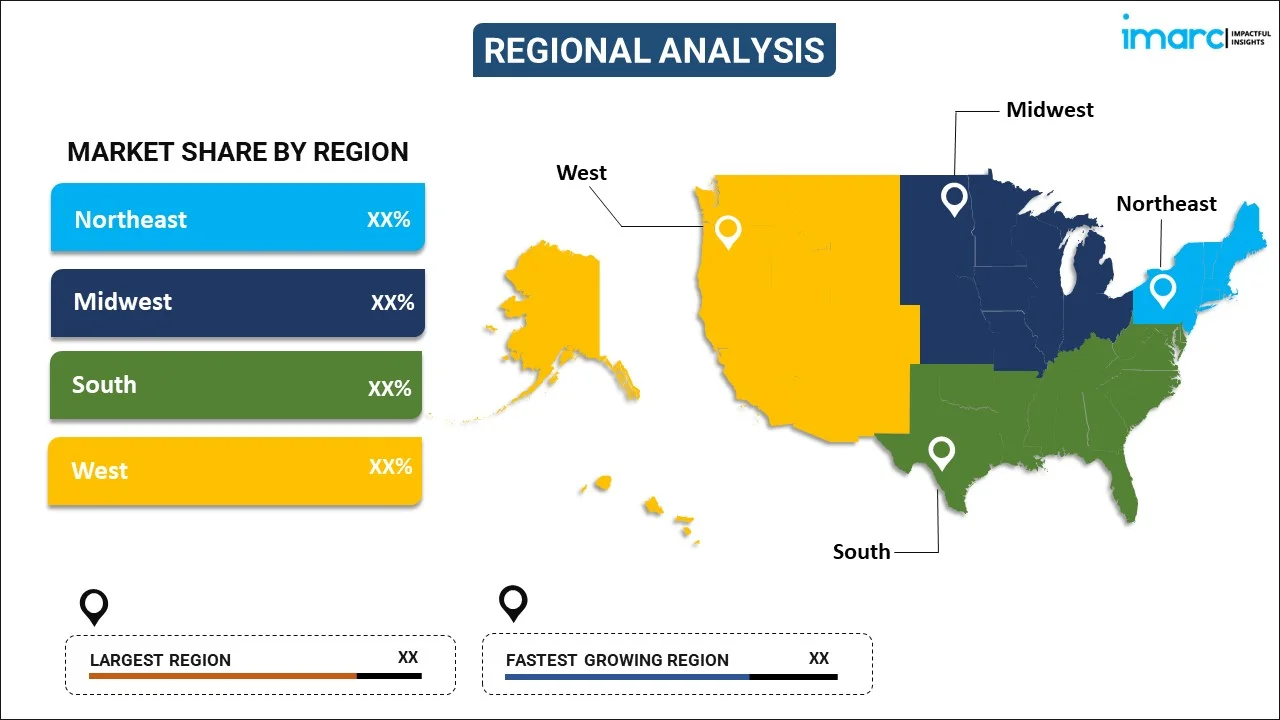
United States Simulation Software Market Report by Component (Software, Service), Deployments (On-premises, Cloud-based), End Use (Automotive, Aerospace and Defense, Electrical and Electronics, Industrial Manufacturing, Healthcare, and Others), and Region 2025-2033
Market Overview:
The United States simulation software market size reached USD 4.8 Billion in 2024. Looking forward, IMARC Group expects the market to reach USD 15.0 Billion by 2033, exhibiting a growth rate (CAGR) of 12.6% during 2025-2033. Rapid technological advancements, the escalating need for efficient product development, the rising demand for risk-free training and research in various industries, and stringent regulatory compliance and safety requirements represent some of the key factors driving the market.
|
Report Attribute
|
Key Statistics
|
|---|---|
|
Base Year
|
2024 |
|
Forecast Years
|
2025-2033
|
|
Historical Years
|
2019-2024
|
| Market Size in 2024 | USD 4.8 Billion |
| Market Forecast in 2033 | USD 15.0 Billion |
| Market Growth Rate (2025-2033) | 12.6% |
Simulation software is a program used to create a virtual representation of a real-world process or system. It enables users to observe and analyze the behavior of a system without physically enacting it. This software is pivotal in numerous industries, including engineering, healthcare, defense, and entertainment, providing a cost-effective and risk-free way to test scenarios and predict outcomes. By modeling complex systems, simulation software facilitates understanding and insight into how these systems function under different conditions. It allows for experimentation with variables and parameters, enabling users to explore 'what-if' scenarios without the need for real-world trials. This capability is particularly beneficial in situations where actual experimentation is impractical, hazardous, or prohibitively expensive. For instance, in engineering, simulation software aids in designing and testing new products, from vehicles to electronic devices, ensuring they meet safety and performance standards before physical prototypes are built. In healthcare, it assists in training medical professionals, allowing them to practice procedures in a virtual environment. The software's versatility extends to business processes, where it helps in optimizing logistics, supply chain management, and resource allocation. As a result, simulation software has gained prominence as a powerful tool that enhances decision-making, improves efficiency, and drives innovation across diverse sectors by providing a virtual platform for testing, learning, and optimizing systems and processes.
United States Simulation Software Market Trends:
The United States simulation software market is witnessing robust growth fueled by various factors across multiple sectors. Key drivers include technological advancements, rising demand for efficient product development, and a growing focus on research and training that requires risk-free environments. Continuous innovations, such as the integration of novel technologies like artificial intelligence (AI), machine learning (ML), and cloud computing, have greatly enhanced the capabilities of simulation software. These technologies enable more realistic and complex simulations, making the software more effective and appealing to a wider range of industries, thus fostering market growth. Moreover, in industries such as automotive, aerospace, and manufacturing, there is a growing need for faster and more cost-effective product development cycles. Simulation software facilitates rapid prototyping and testing without the need for physical models, significantly reducing time and expense and thus accelerating product adoption rates. Additionally, simulation software offers a safe environment for training and research in fields like healthcare, defense, and education. It allows professionals to gain practical experience and test various scenarios without real-world risks, leading to better preparedness and improved outcomes. In line with this, the imposition of stringent safety regulations in numerous sectors, such as healthcare, automotive, and construction, has amplified the need for thorough testing and compliance checks. Simulation software aids in ensuring products and processes meet these rigorous standards, which in turn contributes to market growth. Furthermore, businesses are increasingly using simulation software to optimize supply chains and logistics. This software assists in modeling complex supply networks, predicting disruptions, and finding efficient solutions, which is crucial in today's global economy. Along with this, extensive investments in research and development (R&D) across various industries have catalyzed the demand for advanced tools like simulation software to innovate and develop new products and solutions, thereby propelling market growth.
United States Simulation Software Market Segmentation:
IMARC Group provides an analysis of the key trends in each segment of the market, along with forecasts at the country level for 2025-2033. Our report has categorized the market based on component, deployment, and end use.
Component Insights:

- Software
- Service
The report has provided a detailed breakup and analysis of the market based on the component. This includes software and service.
Deployment Insights:
- On-premises
- Cloud-based
A detailed breakup and analysis of the market based on the deployment have also been provided in the report. This includes on-premises and cloud-based.
End Use Insights:
- Automotive
- Aerospace and Defense
- Electrical and Electronics
- Industrial Manufacturing
- Healthcare
- Others
The report has provided a detailed breakup and analysis of the market based on the end use. This includes automotive, aerospace and defense, electrical and electronics, industrial manufacturing, healthcare, and others.
Regional Insights:

- Northeast
- Midwest
- South
- West
The report has also provided a comprehensive analysis of all the major regional markets, which include the Northeast, Midwest, South, and West.
Competitive Landscape:
The market research report has also provided a comprehensive analysis of the competitive landscape in the market. Competitive analysis such as market structure, key player positioning, top winning strategies, competitive dashboard, and company evaluation quadrant has been covered in the report. Also, detailed profiles of all major companies have been provided.
United States Simulation Software Market Report Coverage:
| Report Features | Details |
|---|---|
| Base Year of the Analysis | 2024 |
| Historical Period | 2019-2024 |
| Forecast Period | 2025-2033 |
| Units | Billion USD |
| Scope of the Report | Exploration of Historical Trends and Market Outlook, Industry Catalysts and Challenges, Segment-Wise Historical and Future Market Assessment:
|
| Components Covered | Software, Service |
| Deployments Covered | On-premises, Cloud-based |
| End Uses Covered | Automotive, Aerospace and Defense, Electrical and Electronics, Industrial Manufacturing, Healthcare, Others |
| Regions Covered | Northeast, Midwest, South, West |
| Customization Scope | 10% Free Customization |
| Post-Sale Analyst Support | 10-12 Weeks |
| Delivery Format | PDF and Excel through Email (We can also provide the editable version of the report in PPT/Word format on special request) |
Key Questions Answered in This Report:
- How has the United States simulation software market performed so far and how will it perform in the coming years?
- What has been the impact of COVID-19 on the United States simulation software market?
- What is the breakup of the United States simulation software market on the basis of component?
- What is the breakup of the United States simulation software market on the basis of deployment?
- What is the breakup of the United States simulation software market on the basis of end use?
- What are the various stages in the value chain of the United States simulation software market?
- What are the key driving factors and challenges in the United States simulation software?
- What is the structure of the United States simulation software market and who are the key players?
- What is the degree of competition in the United States simulation software market?
Key Benefits for Stakeholders:
- IMARC’s industry report offers a comprehensive quantitative analysis of various market segments, historical and current market trends, market forecasts, and dynamics of the United States simulation software market from 2019-2033.
- The research report provides the latest information on the market drivers, challenges, and opportunities in the United States simulation software market.
- Porter's five forces analysis assist stakeholders in assessing the impact of new entrants, competitive rivalry, supplier power, buyer power, and the threat of substitution. It helps stakeholders to analyze the level of competition within the United States simulation software industry and its attractiveness.
- A competitive landscape allows stakeholders to understand their competitive environment and provides an insight into the current positions of key players in the market.
Need more help?
- Speak to our experienced analysts for insights on the current market scenarios.
- Include additional segments and countries to customize the report as per your requirement.
- Gain an unparalleled competitive advantage in your domain by understanding how to utilize the report and positively impacting your operations and revenue.
- For further assistance, please connect with our analysts.
 Request Customization
Request Customization
 Speak to an Analyst
Speak to an Analyst
 Request Brochure
Request Brochure
 Inquire Before Buying
Inquire Before Buying




.webp)




.webp)












